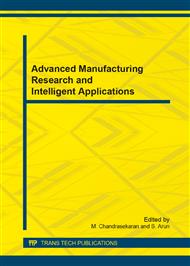p.116
p.120
p.124
p.128
p.132
p.137
p.142
p.146
p.150
Investigate the Fiber Reinforcement Effect on Viscoelastic Response and Thermal Stability of Hybrid Friction Composites
Abstract:
In this work, enhancement of viscoelastic behaviour and thermal stability of hybrid friction composites has been synergistically investigated. Five different friction composites were fabricated by varying weight % of basalt fiber against BaSO4 content. Dynamic mechanical analysis (DMA) was carried out to assess the temperature dependent viscoelastic behaviour of composites. Basalt fibre addition improves dynamic modulus such as storage modulus (E'), loss modulus (E") and lowers the damping factor (tan δ) values. Thermal degradation behaviour and presence of volatile elements in the composites was studied using thermo gravimetric analysis (TGA). Higher amount of BaSO4 resulted in higher thermal stability and lower % of weight loss. Fourier transform infrared spectroscopy (FTIR) and X-ray powder diffraction (XRD) analysis were employed to characterize the composites.
Info:
Periodical:
Pages:
132-136
Citation:
Online since:
July 2014
Authors:
Price:
Сopyright:
© 2014 Trans Tech Publications Ltd. All Rights Reserved
Share:
Citation:


